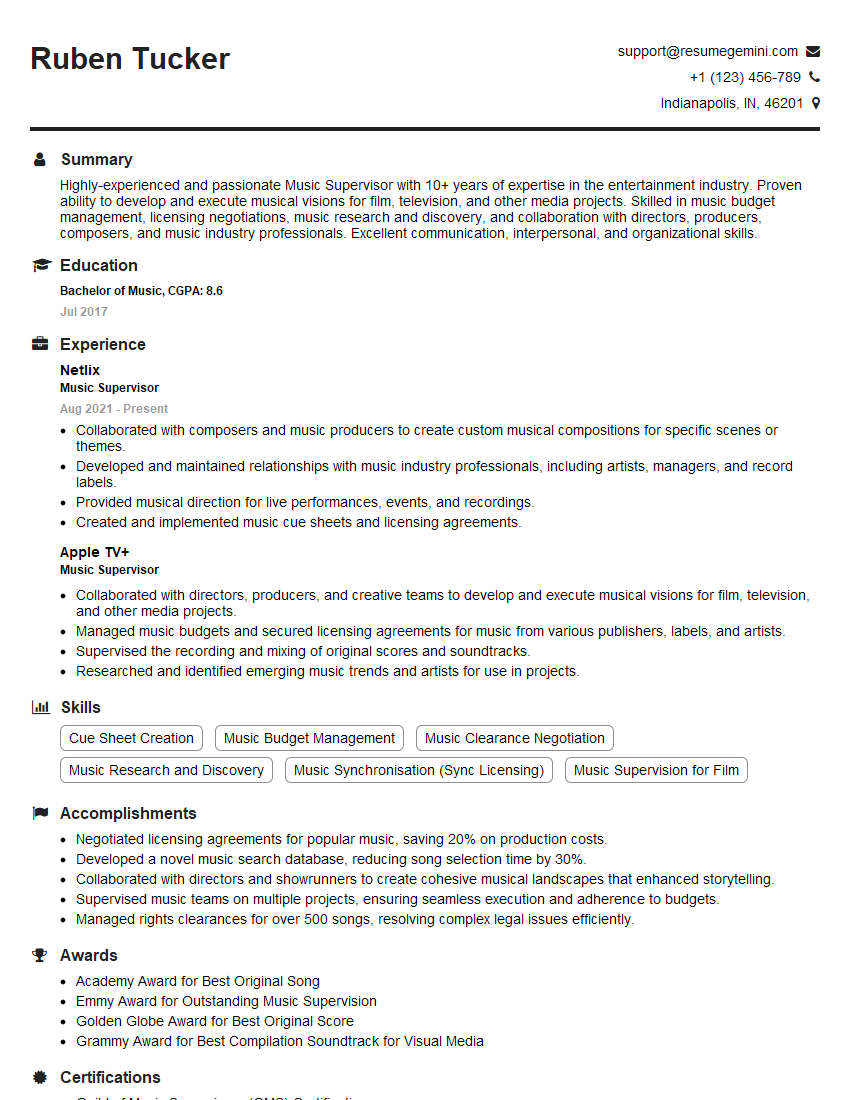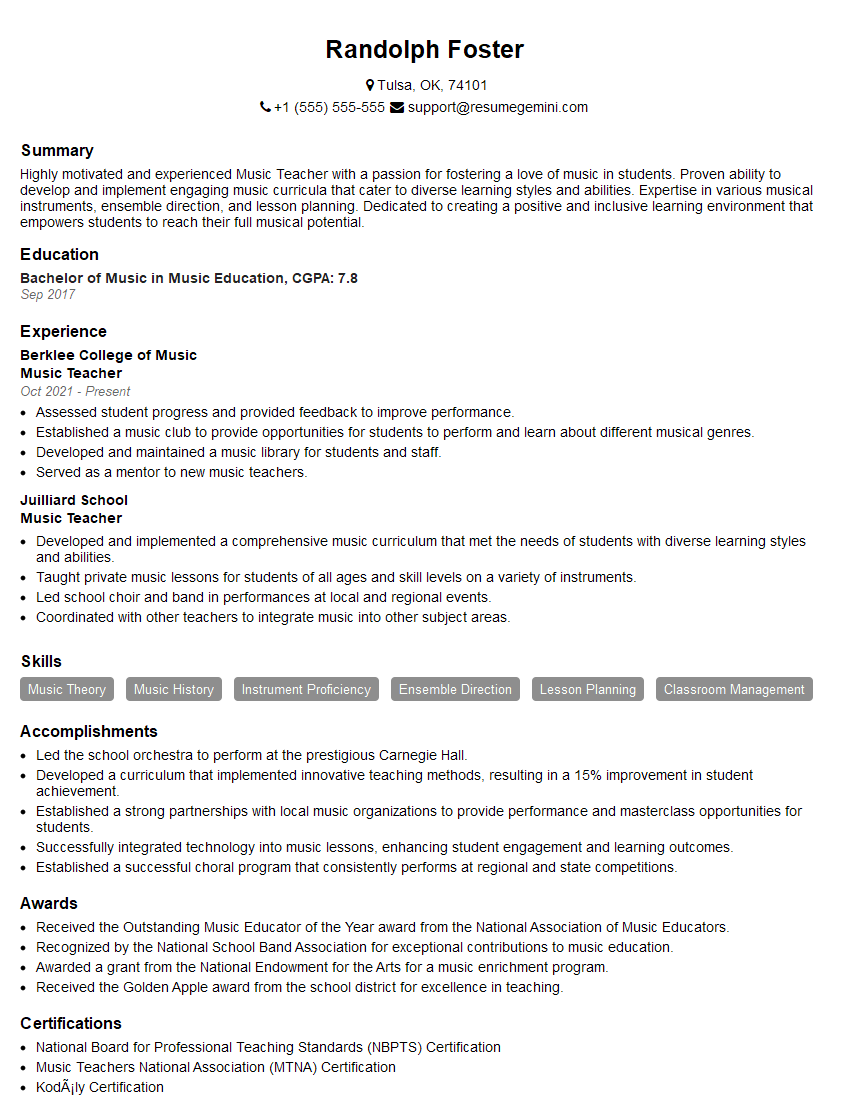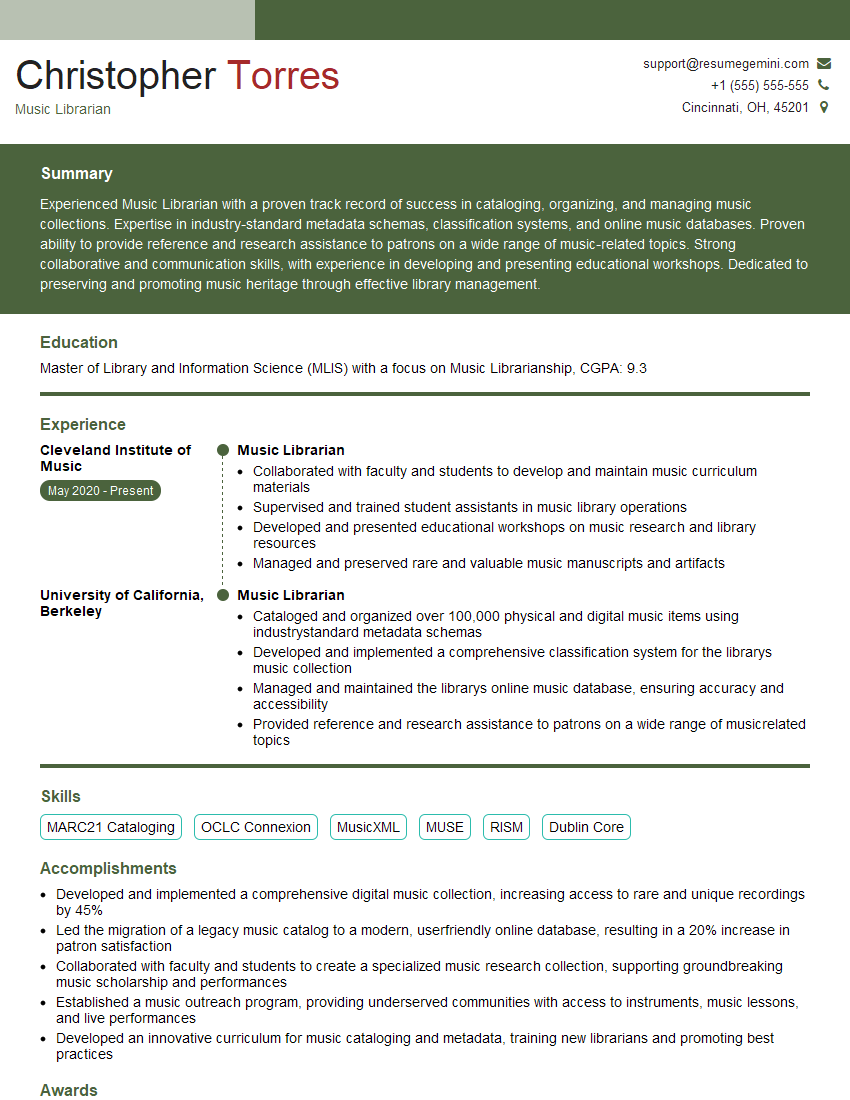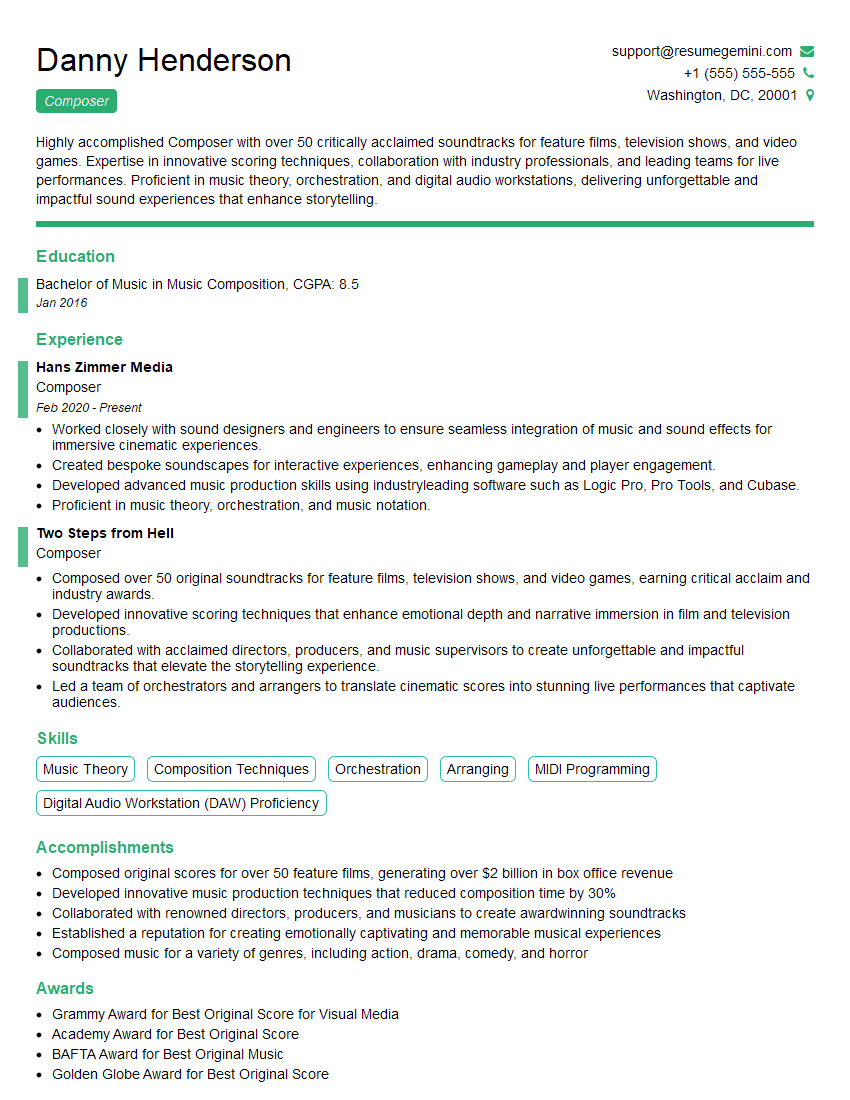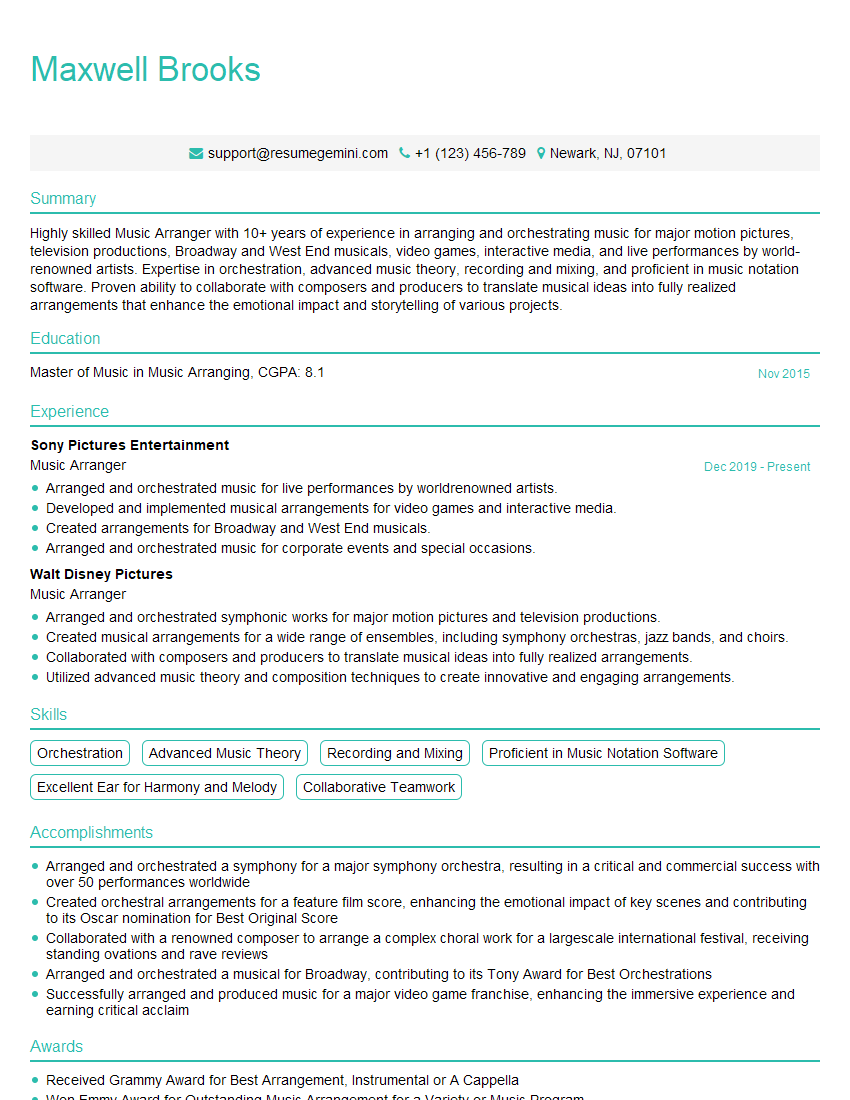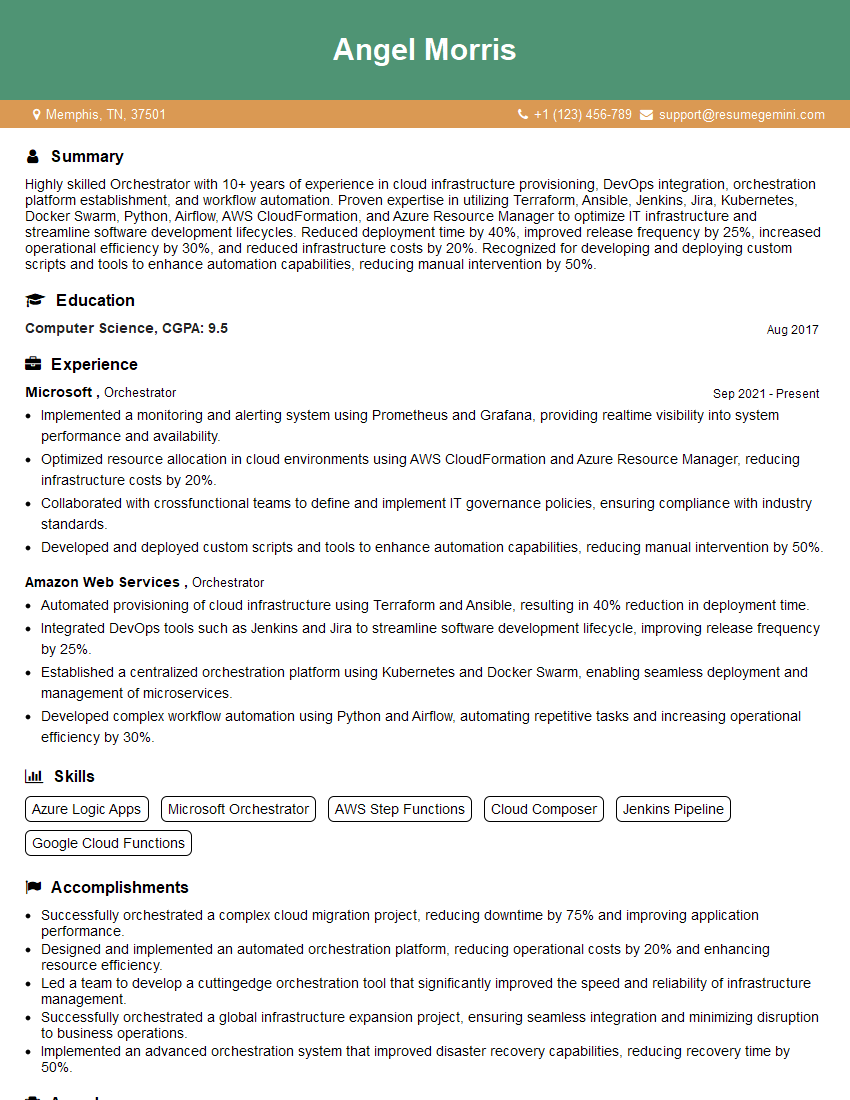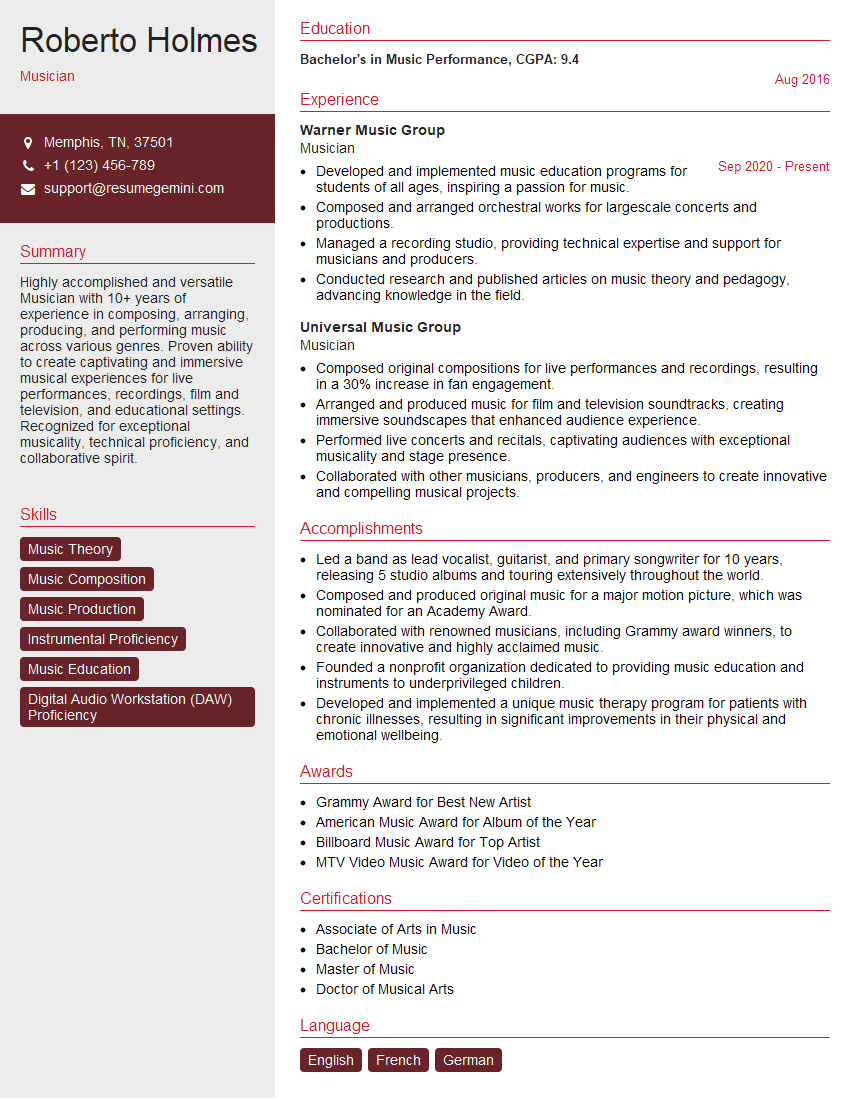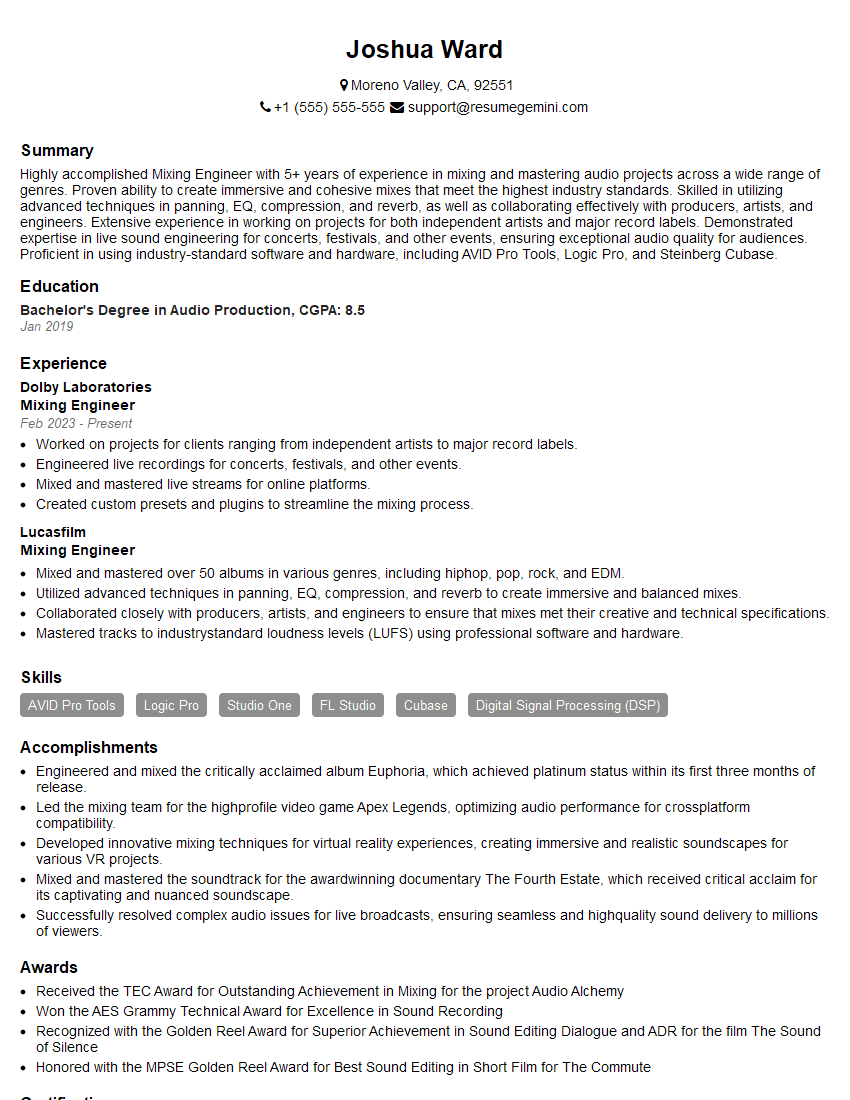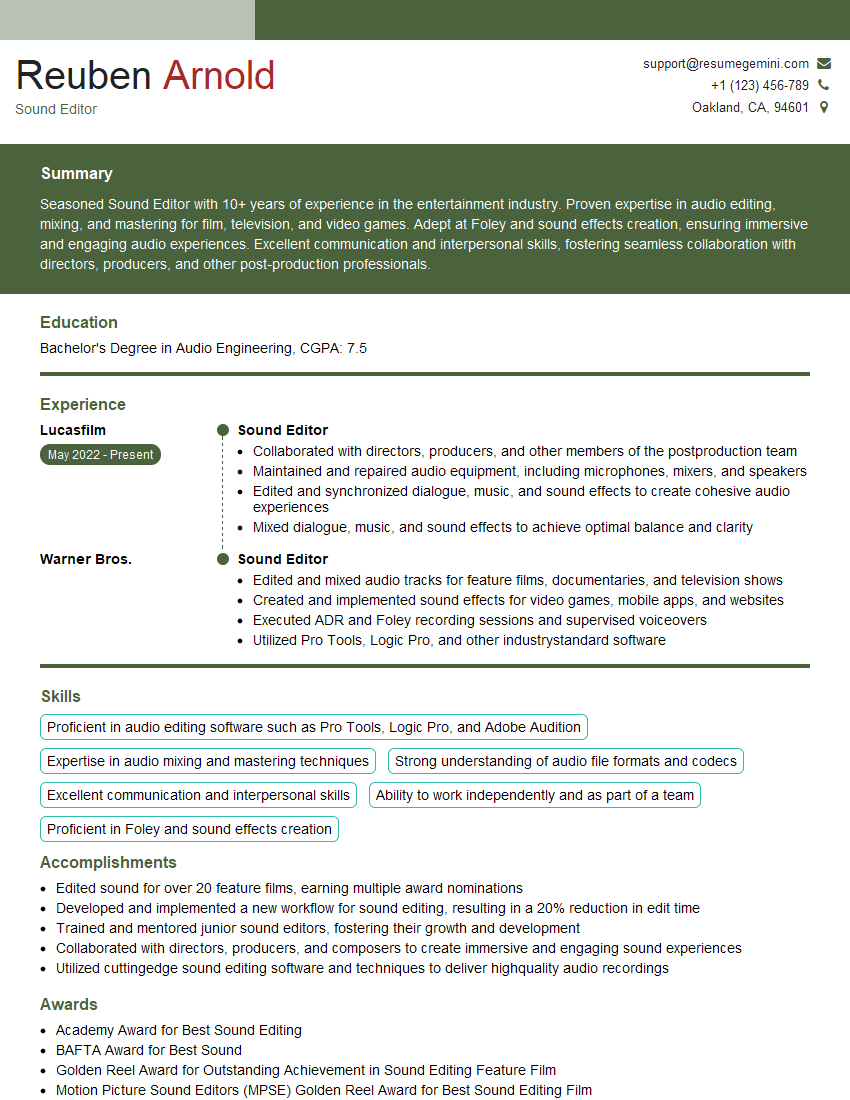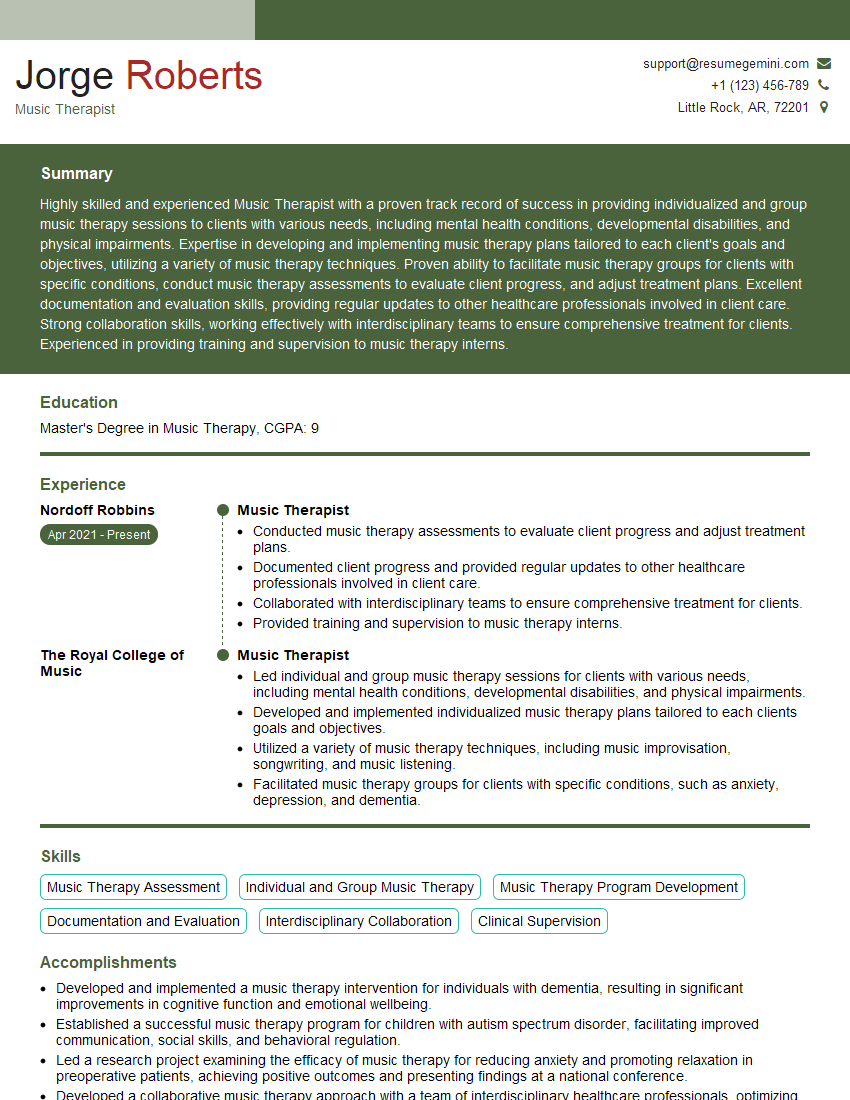Interviews are more than just a Q&A session—they’re a chance to prove your worth. This blog dives into essential Passionate About Music and Sound interview questions and expert tips to help you align your answers with what hiring managers are looking for. Start preparing to shine!
Questions Asked in Passionate About Music and Sound Interview
Q 1. Explain the difference between mixing and mastering.
Mixing and mastering are distinct yet crucial stages in audio post-production. Think of it like baking a cake: mixing is preparing the batter (individual tracks), and mastering is the final finishing touches (overall sound) before it’s ready to be presented.
Mixing focuses on the balance and arrangement of individual audio tracks within a song. This involves adjusting levels, EQ (equalization), compression, panning (stereo positioning), and adding effects to create a cohesive and well-balanced sonic landscape. A mix is like a musical painting, where each instrument and vocal has its own space and color.
Mastering, on the other hand, is the final polishing stage. It optimizes the overall loudness, frequency balance, and dynamic range of the entire mixed track to ensure it translates well across different playback systems (e.g., headphones, car stereo, streaming services). Mastering aims for a consistent and high-quality sound, irrespective of the listener’s playback environment. It’s the final coat of polish on the cake, ensuring it looks and tastes its best.
Q 2. Describe your experience with various DAWs (Digital Audio Workstations).
My experience with DAWs is extensive, encompassing both industry-standard and niche software. I’m highly proficient in Pro Tools, Logic Pro X, and Ableton Live. Pro Tools is my go-to for large-scale projects, offering robust features for mixing and editing, particularly in film and television scoring. Logic Pro X excels in its intuitive workflow and vast sound library, making it ideal for songwriting and pop productions. Ableton Live’s strengths lie in its session view, which facilitates spontaneous composition and looping, perfect for electronic music and live performance applications.
Beyond these major players, I’ve also worked with Cubase, Studio One, and Reaper, gaining a comprehensive understanding of different approaches to audio production. This versatility allows me to adapt my workflow to the specific requirements of each project and client preference.
Q 3. What are your preferred methods for noise reduction and audio restoration?
My noise reduction and audio restoration techniques are highly context-dependent. There’s no one-size-fits-all solution. I generally start with careful spectral analysis to identify the characteristics of the noise. This involves using tools like spectral displays in my DAW to visualize the frequencies of the noise. Once characterized, I tailor my approach accordingly.
For consistent, low-level hiss or hum, I often utilize spectral editing tools to surgically remove or reduce noise in specific frequency ranges. For more complex noise, I might employ sophisticated noise reduction plugins like iZotope RX or Waves plugins. These plugins often incorporate AI-powered algorithms that intelligently identify and reduce noise while preserving the integrity of the original audio. In cases of damaged or degraded audio, I’ll often use a combination of restoration plugins, including tools for click removal, declicking, decrackling, and other forms of repair.
A crucial part of the process involves the use of reference tracks – listening to similar recordings of high quality to guide the restoration and ensure a natural sound.
Q 4. How do you approach EQing different instruments in a mix?
EQing different instruments requires a deep understanding of their frequency characteristics and their role within the overall mix. I always begin by listening carefully to the individual instrument within the context of the entire mix. This helps me identify areas that need attention. For example:
- Kick Drum: I typically focus on the low-end frequencies (below 100Hz) to ensure a powerful and defined low-end, and then subtly boost around 3-5kHz to add some ‘punch’ and cut through the mix.
- Snare Drum: The mid-range frequencies (around 2-4kHz) are key for snare presence and cut, while subtle cuts or boosts around 1kHz-2kHz can adjust its ‘body’ and ‘crack’.
- Vocals: Careful attention to the mid-range (around 2kHz-5kHz) is crucial for intelligibility, while gently cutting muddiness in the low-mids and sibilance in the high frequencies can dramatically improve clarity.
- Guitars: Depending on the type of guitar and its role, I might boost mids for presence, highs for brightness, or cut muddiness in the low-mids.
The process is iterative, with constant listening and adjustments until everything blends harmoniously.
Q 5. What compression techniques do you commonly use and why?
My compression choices are highly dependent on the material and desired effect. I frequently use several different types of compression.
- Transient Shaping: This technique focuses on altering the attack and release times of the signal to affect the dynamics. Using shorter attack times can create punchier sounds, while longer release times can add sustain. This is common on drums and percussive elements.
- Parallel Compression: This involves applying heavy compression to a duplicate of the signal and then blending it with the uncompressed signal. This technique adds glue and punch to a sound without overly squashing the dynamics.
- Multiband Compression: This method allows the application of compression to different frequency bands independently. This provides more refined control over the dynamics in the low, mid, and high frequencies and can fix problems where several instruments are competing in the same frequency range.
The choice of compressor often depends on the type of sound being processed and the desired effect. I commonly use plugins from Waves, Universal Audio, and FabFilter, each offering unique sonic characteristics.
Q 6. Explain your understanding of reverberation and delay effects.
Reverberation and delay are crucial tools for adding depth, space, and character to a mix. Reverberation (reverb) simulates the natural reflections of sound within an environment. It creates a sense of spaciousness and ambience. The characteristics of reverb depend on the size and shape of the simulated space (room size, decay time, etc.).
Delay, on the other hand, is a time-based effect that repeats a signal after a certain delay time. It can create rhythmic patterns, rhythmic textures, and spacious soundscapes. Delay effects are often characterized by parameters like delay time, feedback (how many times the signal repeats), and filter settings (shaping the sound of the repeats).
In a mix, reverb can make a vocal sound more natural in a space, while carefully placed delays can add movement and rhythmic interest. I often use combinations of these effects to achieve the desired sonic texture.
Q 7. Describe your experience with spatial audio techniques.
My experience with spatial audio techniques is growing rapidly with the increasing adoption of immersive audio formats. I have been actively learning and implementing techniques for creating 3D audio experiences using binaural recording, Ambisonics, and object-based audio workflows. This often involves using specialized plugins and tools within my DAW.
Binaural recording creates a highly realistic sense of spatialization by using two microphones mimicking human ear placement. Ambisonics is a technique for encoding and decoding sound in a 3D space. Object-based audio allows for individual sound sources to be positioned and moved within a 3D audio environment, which is perfect for virtual and augmented reality applications. The challenge lies in ensuring a consistent and immersive experience across various playback devices.
Q 8. How do you handle feedback issues during a live sound reinforcement?
Handling feedback in live sound is crucial for a clean and enjoyable listening experience. Feedback, that high-pitched squeal, occurs when sound from a monitor or main speaker is picked up by a microphone and amplified, creating a loop. My approach is multi-pronged and proactive.
- Gain Staging: This is the most important step. I carefully adjust the gain (volume) on each microphone and monitor, ensuring there’s enough signal but avoiding excessive levels. Think of it like turning down the water faucet just enough to get a good flow. Too much, and it’s a flood (feedback).
- Microphone Placement: Proper microphone technique is vital. I avoid pointing microphones directly at speakers and ensure they’re positioned to minimize picking up unwanted sound. Often, a slight angle adjustment can make a big difference.
- EQ: Strategic use of equalization (EQ) can help tame problem frequencies. If feedback is occurring around a specific frequency, I’ll use a narrow cut in the EQ to reduce that frequency’s gain at the source, effectively ‘muting’ the feedback.
- Feedback Destroyers/Notch Filters: Many mixers have built-in feedback detectors or ‘notch filters’. These automatically identify the feedback frequency and reduce it. They’re a great safety net.
- Monitor Mixing: Careful monitor mixes are crucial for performers. I work closely with musicians to ensure their monitors are loud enough, but not so loud that they contribute to feedback. Less is often more.
- Room Acoustics: The room itself plays a major role. Understanding the room’s natural resonances (where certain frequencies build up) and using acoustic treatment (bass traps, diffusers) can greatly reduce feedback occurrences.
I constantly monitor the sound throughout the performance, adjusting levels and EQ as needed to prevent feedback. It’s a dynamic process, requiring both technical knowledge and quick thinking.
Q 9. What are your preferred microphone types and their applications?
My microphone choices depend heavily on the application. There isn’t one ‘best’ microphone, but rather the right tool for the job.
- Large-Diaphragm Condenser Microphones (LDCs): These are my go-to for recording vocals in the studio. Their sensitivity and warm sound capture subtle nuances in the voice. Examples include Neumann U 87 Ai or AKG C414 XLII. I use these for recording vocals that need a more polished, detailed sound.
- Small-Diaphragm Condenser Microphones (SDCs): Excellent for capturing acoustic instruments like guitars or string sections. Their detail and quick transient response is superb. I often choose SDCs for detailed acoustic recordings needing to capture delicate high frequency details.
- Dynamic Microphones: Robust and able to handle high sound pressure levels, these are perfect for live vocals, loud instruments, or close miking of sources in noisy environments. Shure SM58 is a classic for vocal use because of its resilience and feedback rejection.
- Ribbon Microphones: These microphones offer a unique, warm, and often less bright sound. Great for capturing the subtle nuances of instruments like guitars or horns. They offer a more ‘vintage’ sonic characteristic often sought in recording projects.
For example, recording a quiet acoustic guitar in a studio, I might opt for an SDC. For a powerful lead vocalist performing live, a dynamic mic like the Shure SM58 would be ideal.
Q 10. Explain your workflow for recording vocals.
My vocal recording workflow emphasizes capturing the best possible performance first, then enhancing it in post-production.
- Pre-Production: We discuss the song, the desired tone, and any specific vocal techniques with the artist. I set up the recording space to minimize background noise and unwanted reflections. A proper listening environment is essential for artist comfort and performance.
- Microphone Selection and Placement: I choose a microphone appropriate for the vocalist’s voice and the style of music. This could be an LDC for warm, detailed sound or a dynamic mic for a more present and upfront sound. Proper placement minimizes plosives (those harsh ‘p’ and ‘b’ sounds) and maximizes clarity.
- Recording the Performance: Multiple takes are encouraged to capture different interpretations and to find the perfect delivery. Comfortable artists always perform better.
- Post-Production Editing and Processing: Using Digital Audio Workstations (DAWs) such as Pro Tools or Logic Pro X, I edit out any mistakes or unwanted sounds. I then use EQ, compression, and other plugins to shape the vocal tone and ensure it sits well within the mix. A lot of my focus here is on smoothing out vocal inconsistencies and making the vocals sit comfortably in the mix. This process usually involves several passes to refine detail and ensure balance.
- Mixing and Mastering: The vocals now need to sit well within the entire mix. This is where I carefully adjust levels, pan, and EQ to ensure clarity and impact. This requires extensive listening and attention to detail. Mastering aims to optimize the final sound for various playback platforms, ensuring a consistent and high-quality listening experience across different devices.
Q 11. How do you approach creating a balanced and dynamic mix?
Creating a balanced and dynamic mix requires a keen ear and understanding of how different frequencies and instruments interact. It’s an iterative process.
- Frequency Balancing: The goal is to ensure that all instruments and vocals have their own space in the frequency spectrum without clashing. This involves using EQ to sculpt the sounds, carving out space for instruments to breathe and avoiding muddiness in the low-end or harshness in the high-end. I often use reference tracks to compare my mix to professional standards.
- Gain Staging: Careful gain staging ensures that no single instrument overpowers the others. This avoids clipping (distortion caused by excessive signal) and keeps everything within a healthy dynamic range.
- Stereo Imaging: Spreading instruments across the stereo field adds depth and dimension to the mix. Panning instruments strategically makes a mix sound wider, giving an airy feel.
- Dynamics Processing: Compressors and limiters control dynamic range, bringing louder parts down and quieter parts up for a more consistent sound. This can add punch and energy to a mix. Careful use is key, as over-compression can make a mix sound unnatural and lifeless.
- Automation: Using automation allows for dynamic changes in levels, EQ, and effects throughout the song. This is crucial for creating a sense of movement and evolution.
Think of it like painting a picture: each instrument is a color, and the mix engineer is the artist, blending the colors to create a cohesive and visually appealing piece of work.
Q 12. Describe your experience with MIDI and virtual instruments.
I have extensive experience with MIDI (Musical Instrument Digital Interface) and virtual instruments (VSTs). MIDI is a protocol that allows electronic musical instruments, computers, and other devices to communicate with each other. VSTs are software instruments that emulate the sound of real instruments or create entirely new sounds.
- MIDI Sequencing: I use MIDI to program drum beats, create melodies and harmonies using virtual synthesizers, and control other aspects of the music production process. I often use MIDI controllers like keyboards to play virtual instruments in a more intuitive way.
- Virtual Instrument Selection: The choice of virtual instruments depends greatly on the music style. For example, a grand piano VST might be suitable for classical music, while a synthesizer VST might be ideal for electronic music. VSTs provide a vast library of sounds that give creative flexibility in any project.
- Sound Design: Many VSTs allow for deep sound design capabilities. This allows for customized sounds, not restricted by the limitations of traditional instruments. This gives me an extensive palette of timbres and sonic characteristics to choose from.
- Integration with DAWs: VSTs integrate seamlessly with DAWs, allowing for efficient workflow and creative flexibility. This allows a comprehensive system that links recording, editing, and creative synthesis together seamlessly.
For instance, I might use a MIDI keyboard to play a piano VST for a ballad, then switch to a drum machine VST to program a beat for a pop song. The possibilities are virtually endless.
Q 13. How do you troubleshoot technical issues during a recording session?
Troubleshooting during a recording session requires a systematic approach. My process typically follows these steps:
- Identify the Problem: Pinpoint the exact nature of the issue. Is it a sound quality problem, a software glitch, a hardware malfunction, or something else? Systematic testing eliminates potential problem areas.
- Check the Obvious: Are cables plugged in correctly? Is the power on? Are levels set appropriately? Often, the simplest solutions are overlooked.
- Isolate the Source: Try different equipment or software components to isolate the source of the problem. A step-by-step process of elimination is always most efficient.
- Consult Documentation: Check manuals, online forums, and other resources for solutions to common problems. This is where a lot of simple solutions can be found quickly.
- Seek External Help: If the problem persists, don’t hesitate to seek help from experienced colleagues or technical support. Sometimes, a fresh pair of eyes can spot something you’ve missed.
For example, if I encounter a distorted signal, I might first check the gain settings, then the cables, and finally, consider whether the audio interface itself might be faulty. A methodical process ensures solutions are found efficiently.
Q 14. What are your preferred methods for music notation software?
My preference for music notation software depends on the project’s specific needs, but I’m proficient in several popular programs.
- Sibelius: Excellent for professional-grade orchestral scores and complex musical arrangements. Its powerful features and versatility make it ideal for large-scale projects. This program excels in its accuracy and clarity for intricate notations.
- Finale: Another industry-standard notation program, Finale is known for its robust features and user-friendly interface. It offers many of the same features as Sibelius, making it a strong alternative.
- Dorico: A newer program rapidly gaining popularity, Dorico combines powerful features with an intuitive workflow. Its modern design makes a lot of complex operations simplified and efficient.
- MuseScore: A free and open-source option, MuseScore is excellent for simpler projects and learning notation. While it lacks some of the advanced features of the other programs, it’s a great starting point for anyone looking to learn music notation.
The choice often depends on budget, project complexity, and personal preference. For instance, for a complex orchestral score, I might choose Sibelius, but for quickly jotting down ideas, MuseScore could suffice.
Q 15. Describe your experience with different audio file formats.
My experience with audio file formats spans a wide range, from lossless to lossy compression techniques. Lossless formats, like WAV and AIFF, preserve all audio data, resulting in pristine quality but larger file sizes. These are ideal for mastering and archiving. Lossy formats, such as MP3, AAC, and FLAC, discard some audio data to reduce file size, trading quality for efficiency. MP3 is ubiquitous but can suffer from artifacts at lower bitrates. AAC offers better quality at comparable bitrates. FLAC, a lossless codec, provides a good balance of quality and file size, making it a popular choice for music enthusiasts. I’ve worked extensively with all these formats, choosing the appropriate one based on the project’s specific needs and intended use. For example, I’d use WAV for studio recording and mastering, and MP3 for online distribution where file size is a crucial factor.
- WAV (Waveform Audio File Format): Lossless, high quality, large file size.
- AIFF (Audio Interchange File Format): Lossless, high quality, large file size, primarily used on Apple systems.
- MP3 (MPEG Audio Layer III): Lossy, smaller file size, widely used for online streaming and distribution.
- AAC (Advanced Audio Coding): Lossy, generally better quality than MP3 at the same bitrate.
- FLAC (Free Lossless Audio Codec): Lossless, good balance between quality and file size.
Career Expert Tips:
- Ace those interviews! Prepare effectively by reviewing the Top 50 Most Common Interview Questions on ResumeGemini.
- Navigate your job search with confidence! Explore a wide range of Career Tips on ResumeGemini. Learn about common challenges and recommendations to overcome them.
- Craft the perfect resume! Master the Art of Resume Writing with ResumeGemini’s guide. Showcase your unique qualifications and achievements effectively.
- Don’t miss out on holiday savings! Build your dream resume with ResumeGemini’s ATS optimized templates.
Q 16. Explain your understanding of psychoacoustics.
Psychoacoustics is the study of how humans perceive sound. Understanding this is crucial for sound design and mixing. It acknowledges that our ears don’t process all frequencies equally; we’re more sensitive to certain frequencies than others, and our perception of loudness is non-linear. For instance, the ‘masking effect’ explains how louder sounds can obscure quieter sounds at nearby frequencies. This knowledge informs decisions like strategic EQ adjustments to enhance clarity or reduce muddiness in a mix. Similarly, understanding the Haas effect, where our brain perceives a sound as coming from the location of the first arriving signal, is fundamental to creating a realistic stereo image and spatial audio. I incorporate psychoacoustic principles to make mixes sound full and clear while optimizing audio for different playback systems.
For example, when mixing a track, I might use compression to reduce the dynamic range, making it sound louder to the listener without necessarily increasing the overall volume, thus playing with the perception of loudness. Conversely, I would avoid placing two instruments with similar frequencies too close together in the frequency spectrum, mitigating muddiness due to masking. Knowing psychoacoustics prevents over-processing and helps achieve a balanced and pleasing sonic outcome.
Q 17. How familiar are you with different speaker systems and their characteristics?
My familiarity with speaker systems is extensive. I understand that different speakers have unique frequency responses, directivity patterns, and power handling capabilities. This impacts how a mix translates across various listening environments. I’ve worked with studio monitors, which are designed for accurate sound reproduction, allowing for precise mixing decisions. I’ve also had experience with consumer speakers, headphones, and surround sound systems, each posing unique challenges in terms of tonal balance and spatial audio reproduction. For instance, studio monitors typically have a flat frequency response, while consumer speakers might have a boosted bass response. I consider these variations when preparing a master for different output mediums, ensuring a consistent listening experience across diverse playback systems. My workflow often involves checking mixes on a variety of speakers to catch any anomalies and optimize for the target playback environment.
Q 18. Describe your approach to creating immersive sound design.
Creating immersive sound design involves leveraging spatial audio techniques like binaural recording, 3D audio, and ambisonics. My approach begins with careful consideration of the sonic environment. I visualize the sound’s location, movement, and interaction with the listener and the virtual space. I use techniques like panning, delay, and reverb to precisely place sounds within this environment. I’m proficient with various DAWs and plugins which provide tools for spatial audio manipulation. For example, I may utilize binaural recordings to achieve a highly realistic and immersive soundscape for headphone listeners, or use ambisonics to create a 360-degree sound field for more advanced speaker setups. The process involves iterative refinement, listening across various playback systems, and continually adjusting the sound placement and spatial cues to optimize the immersive experience.
For example, in creating soundscapes for a virtual reality experience, I’d build layers of ambient sounds, effects and foreground sounds, carefully placing these sounds in 3D space to create a believable environment that enhances user engagement.
Q 19. How do you manage your time effectively during a busy project?
Effective time management during busy projects relies on meticulous planning and organization. I begin by breaking down the project into smaller, manageable tasks, prioritizing them based on urgency and importance. I use project management tools to track my progress and deadlines. I also allocate specific time blocks for each task, aiming for focused work sessions with short breaks in between. This approach (Pomodoro Technique, for example) helps maintain productivity and prevent burnout. Regular communication with team members ensures everyone is aligned and potential roadblocks are addressed promptly. Furthermore, I learn to say ‘no’ to tasks that don’t align with project goals or exceed my capacity. Proactive planning and disciplined execution prevent last-minute rushes and ensure projects are completed to a high standard and on time.
Q 20. What is your experience with sound libraries and sample packs?
I have extensive experience with sound libraries and sample packs. They are invaluable resources for enriching projects and saving time. I’m familiar with many reputable libraries, both commercial and royalty-free, and I know how to efficiently search and select samples that fit a project’s aesthetic. I understand the importance of licensing and always adhere to the terms of use for any sample I incorporate. I don’t just rely on pre-made sounds, though. I often process and modify samples to suit the specific needs of a project; I might layer, manipulate, or resample to create unique sounds that retain their character. Selecting the right library, understanding the terms of use and creative manipulation of samples to seamlessly integrate into the project is a critical skill for a sound designer.
Q 21. How do you collaborate effectively with other musicians or engineers?
Effective collaboration hinges on clear communication and mutual respect. I believe in proactive communication, ensuring everyone understands the project’s goals and individual roles. I use collaborative platforms to share files and provide feedback efficiently. Active listening and constructive criticism are key. I’m always open to different perspectives and value the input of others. I’m comfortable explaining technical concepts clearly and concisely, bridging the gap between technical expertise and creative vision. For instance, when collaborating with a composer, I’ll ensure we’re both on the same page regarding the sonic palette, ensuring my sound design complements the musical composition and enhances the overall artistic vision.
Q 22. Describe a challenging project you faced and how you overcame it.
One of the most challenging projects I undertook involved composing the score for an independent film with a very limited budget and tight deadline. The director had a very specific vision, demanding a score that was both emotionally evocative and technically innovative, using unconventional instrumentation. The challenge wasn’t just creative, but also logistical. We had limited access to professional recording studios and a small team.
To overcome this, I adopted a multi-pronged approach. First, I meticulously planned the score, creating detailed mock-ups and leveraging readily available software to prototype sounds before committing to expensive recording sessions. This allowed for efficient revisions and avoided costly mistakes. Second, I collaborated closely with the director throughout the process, ensuring that the musical direction aligned perfectly with the film’s narrative. Open communication was key to managing expectations and addressing concerns promptly. Third, I explored creative solutions for instrumentation, using freeware VST instruments and creatively layering sounds to achieve a fuller, richer orchestral feel without the cost of a full orchestra. The final result was a score that was critically acclaimed and perfectly suited the film, demonstrating that resourcefulness and collaborative spirit can triumph over limitations.
Q 23. What are your preferred methods for music composition?
My music composition methods are highly iterative and often involve a blend of top-down and bottom-up approaches. I frequently begin with a conceptual framework – a mood, a narrative, or a specific emotional arc I want to evoke. This gives me a guiding principle for the overall structure and tone of the piece. Then, I might start experimenting with melodies, harmonies, or rhythms, often using a digital audio workstation (DAW) like Ableton Live or Logic Pro X.
I find that working with different instruments and sounds in my DAW helps me to explore various sonic palettes. Sometimes a simple piano sketch will inspire a more complex orchestral arrangement, while other times the rhythmic foundation dictates the melody. I frequently utilize both traditional music theory – understanding scales, chords, and harmony – and more experimental techniques such as sound design and sampling to create unique textures and soundscapes. The process is rarely linear; I often revisit and refine earlier sections as the composition evolves.
Q 24. What are your strengths and weaknesses in music production?
My strengths in music production lie in my ability to create rich and detailed soundscapes, blending acoustic and electronic elements seamlessly. I’m proficient in various DAWs, possess a strong understanding of mixing and mastering techniques, and have a keen ear for detail. I also pride myself on being a collaborative team player, readily adapting to different working styles and taking constructive criticism positively.
However, like any artist, I have areas for improvement. One area I’m actively working on is enhancing my proficiency in advanced sound design techniques; while I can create pleasing sounds, mastering more complex synthesis and sound manipulation methods would allow me to expand my creative possibilities. Another area is refining my workflow for large-scale projects; managing multiple tracks and sessions efficiently is an ongoing pursuit.
Q 25. How do you stay up-to-date with the latest music technology?
Staying current with music technology is crucial. I regularly subscribe to industry publications like Sound on Sound magazine and follow prominent figures and companies in the music technology space on social media platforms. I also actively participate in online forums and communities dedicated to music production and sound engineering, engaging in discussions and learning from the experiences of other professionals.
Attending workshops, conferences (like NAMM), and webinars also provide invaluable opportunities to learn about new software, hardware, and techniques. Experimenting with new plugins, DAW features, and hardware is a critical part of my process; hands-on experience is the best way to truly understand and incorporate new tools into my workflow. I also believe in continuous learning, investing time in online courses and tutorials to expand my skill set in areas such as sound design, mixing, and mastering.
Q 26. Explain your understanding of different musical genres and styles.
My understanding of musical genres and styles is extensive, encompassing a broad spectrum from classical and jazz to electronic music and various popular genres. I possess a deep appreciation for the historical evolution of different styles, recognizing their unique characteristics, technical approaches, and cultural contexts. For example, I understand the harmonic complexities of Baroque music, the improvisational nature of jazz, the rhythmic drive of funk, and the technological innovations driving electronic dance music.
My knowledge extends beyond mere categorization; I appreciate the nuances and hybrid genres that constantly emerge. I can identify the subtle differences between subgenres within broader categories, such as the variations in tempo and instrumentation that distinguish different forms of electronic music, or the stylistic evolution within hip-hop across decades. This broad perspective allows me to approach composition and production with a level of flexibility and adaptability crucial for modern music creation.
Q 27. How familiar are you with music theory and harmony?
My familiarity with music theory and harmony is comprehensive. I have a solid understanding of scales, modes, chords, chord progressions, counterpoint, and voice leading. I can analyze musical scores, identify harmonic functions, and create original compositions grounded in strong theoretical principles. This understanding is not just theoretical but practical; it informs my compositional choices, allowing me to create music that is both structurally sound and emotionally resonant.
For example, I can easily transpose a melody to a different key, write four-part harmonies, and create interesting chord progressions that support a specific mood or emotional arc. My knowledge of music theory isn’t just limited to Western classical traditions; I also understand the theoretical underpinnings of various non-Western musical systems, broadening my creative palette.
Q 28. Describe your experience with music editing and post-production.
My experience with music editing and post-production is extensive, spanning various stages from initial recording cleanup to final mastering. I am proficient in using DAWs to edit audio, remove unwanted noise and artifacts, and apply various audio effects. I am also skilled in manipulating audio to achieve specific sonic results, such as creating unique reverb effects or adjusting the dynamic range of a track.
I have a strong understanding of the principles of audio editing, including time stretching, pitch correction, and audio restoration. I understand the importance of maintaining audio fidelity throughout the post-production process and utilize appropriate techniques to ensure that the final product is of the highest quality. My experience encompasses working with both individual tracks and complex multi-track projects, demonstrating my ability to manage large and intricate audio projects effectively and efficiently.
Key Topics to Learn for a Passionate About Music and Sound Interview
- Acoustic Principles: Understanding sound waves, frequency, amplitude, timbre, and their impact on music production and perception. Consider practical applications like microphone placement and equalization techniques.
- Music Theory Fundamentals: Key signatures, scales, chords, rhythm, and melody. Think about how this knowledge informs your understanding of musical composition and arrangement.
- Digital Audio Workstations (DAWs): Proficiency in at least one DAW (e.g., Pro Tools, Logic Pro X, Ableton Live). Focus on practical skills like recording, editing, mixing, and mastering audio.
- Signal Processing: Learn about effects processing (reverb, delay, compression, etc.) and their practical application in achieving desired sonic results. Consider troubleshooting common audio issues.
- Audio Engineering Principles: Gain a solid understanding of concepts like impedance matching, gain staging, and noise reduction. Be prepared to discuss problem-solving approaches in a studio environment.
- Music Production Techniques: Explore various approaches to songwriting, arrangement, and production, showcasing your understanding of different musical genres and styles.
- Sound Design: Develop skills in creating and manipulating sounds using synthesizers, samplers, and other sound design tools. Be able to discuss your creative process.
Next Steps
Mastering the fundamentals of music and sound is crucial for career advancement in this exciting field. A strong understanding of these concepts will set you apart and open doors to a wide range of opportunities. To maximize your job prospects, it’s essential to create a resume that showcases your skills and experience effectively, especially one that’s ATS-friendly. We highly recommend using ResumeGemini to build a professional and impactful resume. ResumeGemini offers a streamlined process and provides examples of resumes tailored to roles within the Passionate About Music and Sound industry. Take advantage of this resource to present yourself in the best possible light.
Explore more articles
Users Rating of Our Blogs
Share Your Experience
We value your feedback! Please rate our content and share your thoughts (optional).
What Readers Say About Our Blog
Hello,
We found issues with your domain’s email setup that may be sending your messages to spam or blocking them completely. InboxShield Mini shows you how to fix it in minutes — no tech skills required.
Scan your domain now for details: https://inboxshield-mini.com/
— Adam @ InboxShield Mini
Reply STOP to unsubscribe
Hi, are you owner of interviewgemini.com? What if I told you I could help you find extra time in your schedule, reconnect with leads you didn’t even realize you missed, and bring in more “I want to work with you” conversations, without increasing your ad spend or hiring a full-time employee?
All with a flexible, budget-friendly service that could easily pay for itself. Sounds good?
Would it be nice to jump on a quick 10-minute call so I can show you exactly how we make this work?
Best,
Hapei
Marketing Director
Hey, I know you’re the owner of interviewgemini.com. I’ll be quick.
Fundraising for your business is tough and time-consuming. We make it easier by guaranteeing two private investor meetings each month, for six months. No demos, no pitch events – just direct introductions to active investors matched to your startup.
If youR17;re raising, this could help you build real momentum. Want me to send more info?
Hi, I represent an SEO company that specialises in getting you AI citations and higher rankings on Google. I’d like to offer you a 100% free SEO audit for your website. Would you be interested?
Hi, I represent an SEO company that specialises in getting you AI citations and higher rankings on Google. I’d like to offer you a 100% free SEO audit for your website. Would you be interested?
good
